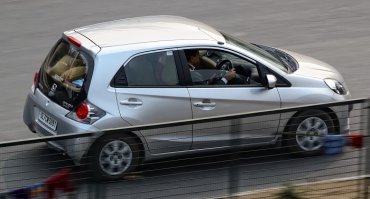As warranties expire on the first waves of Indonesia’s low-cost green cars, independent automobile workshops are likely to see significant growth in their oil change business, according to Ipsos Business Consulting.
Approximately 51,180 cars that first hit the road in 2013 as part of Indonesias low-cost green cars policy will reach the end of their service warranty periods this year. Around 172,000 additional units warranties will expire next year, followed by nearly 400,000 in 2018, Ipsos found in a recent study.

Photo: Nadir Hashmi – CreativeCommons / Flickr
Low-cost green cars, such as the Honda Brio, are becoming the second-most popular car type in Indonesia.
After the service warranties for these vehicles expire, owners will be able to choose their oil products and oil change service providers, Ipsos noted. In LCGCs do-it-for-me market, Ipsos believes that independent workshops will pick up the largest share, due to their convenience and cheaper cost.
This could pose a threat to the oil manufacturers who mainly sell their lubricants at the respective authorized dealers, resulting in loss of sales, said Domy Halim, Ipsos senior consulting manager.
An LCGC is defined by Indonesias government as either a spark-ignited motor vehicle with less than a 1,200 cubic centimeter cylinder capacity and fuel economy of 20 kilometers per liter or more, or as a compression-ignited motor vehicle with less than 1,500 cc and fuel economy of at least 20 kilometers per liter. The country implemented a regulation in 2013 to encourage the purchase of LCGCs which includes a 10-percent luxury goods value-added tax.
According to Ipsos research, the first batch of LCGCs consumed about 610,000 liters of lubricants per year for the past two years.
Although mineral oils are cheaper than semi-synthetic lubricants in Indonesia by a few dollars per liter (U.S. $3-$4, compared to $5-$6.50), Domy said most LCGC owners can afford to spend extra on semi-synthetics and will likely continue to do so. In authorized workshops, the use of semi-synthetics is recommended for LCGCs, Domy added. We believethat this grade will still be used by LCGC owners even if they go to independent aftermarket [workshops] when their warranty expires.
Owners are unlikely to make the jump to full-synthetics, which cost $10 to $13 per liter. And since the vehicles original equipment manufacturers do not specify full-synthetic lubricants, mechanics will not typically recommend it, Domy added.
About 50 percent to 60 percent of lubricants sold in independent service centers are local brands, with foreign brands like Shell and Castrol halving the remaining share, he added.
Shell and Castrolwereable to have solidfootholds in Indonesias independent service centers channel, partlydue to the better incentives these brands offer to mechanics, Domy said, referring to awards for hitting sales targets that include free holiday trips, free lubricants and more. Suppliers incentives are critical in influencing mechanics to recommend foreign products over local brands, he said.
Other foreign players, like Spains Repsol and Malaysias Petronas, intend to penetrate the independent workshop channels and adopt similar incentive programs, benefiting mainly the mechanics, said Domy.Foreign lubricant players are relatively aggressive in converting independent workshops into their branded workshops as part of their sales campaigns. These converted workshops are usually bigger in size and will be heavily branded.
Annual sales of LCGCs increased at a compound annual growth rate of 74 percent from 2013to2015 in Indonesia, and Ipsos forecasts that the fleet will continue to grow. This is despite relatively lowersales in 2015 (about 155,602 units) compared to 2014 (about 172,120 units), he added.
In 2013, LCGCs made up about 6 percent of total passenger vehicle sales in Indonesia, andby2015, their share of the market more than tripled to around 21 percent.
This has resulted in LCGCs becoming the second-most popular car type in Indonesia in terms of annual sales, overtaking SUVs, which had a 19 percent share in 2015, he noted. Multi-purpose vehicles remain the king in Indonesia with an approximately 47 percent share in 2015. Ipsos expects the share of LCGCs to remain solid at 23 percent by 2020.